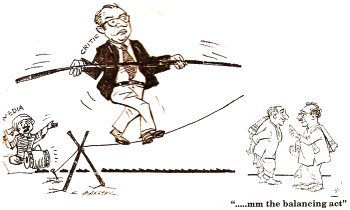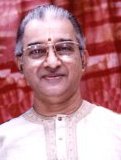
|
 |

|
 |
The art critic - V P Dhananjayan, Chennai e-mail: bkalanjali@gmail.com October 12, 2008 The article re-produced here is courtesy the book 'Beyond Performing Art and Culture, Politico-Social Aspects' by VP Dhananjayan. In the days of kings and zamindars, the performing arts like music and dance were highly regarded and the practitioners were respected for their scholarship. The purpose of the performing arts was to educate the illiterate, enlighten the literate and entertain the enlightened. The technical nuances of the classical art forms certainly were critically analysed and enjoyed by a class highly enlightened. This does not mean the ordinary people were not exposed to the art. Stage by stage and step-by-step, the common folk have been elevated to a scholarly critical audience. 'Naatyam tan naatakam chaiva' - a thematic drama with limited gesticulation or literary content appeals to the common man without much effort. 'Bhaavaabinaya heenamtu nrutta mithyabhideeyathe' - bereft of sophisticated gesticulations or communicative expressions, 'nrutta' is enjoyed by the common man as it does not tax his intelligence. 'Rasa bhaava vyanjanadiyuktam nrutya mityabhidheeyathe' - a combination of bhaava-rasa, sophisticated gestures and literary content becomes a scholar's delight and is usually suitable for - 'Mahaaraja sabhaayaam kalpayet sadaa' - the courts of Kings and Lords. This theory is quite relevant even today. For instance, a thousand people (common men) enjoy a dance-drama or group dance. Through that, they are introduced to music, rhythm and simple movements. Out of the thousand, a few get interested in rhythmical movements and start enjoying the abstract dance movements in a Jateeswaram or the 'theermanams' in a Varnam or a fast tillana. After watching these in a dance recital, a few are introduced to the elements of hand gestures and literature and slowly they develop a taste for more sophisticated gestures, expressions, music and literature. Therefore, even when we present the classical arts to the more educated people, no one becomes a connoisseur overnight. It takes time to develop an appreciation for the classical arts. Similarly, the best way to appreciate classical music is through Bhajans, group singing and so on.  The Sabhanayaka lakshana or qualifications to be a president of an audience, are enunciated in Abhinaya Darpana. These are applicable to a dance critic as well. I believe that these theories will still be relevant in the centuries to come. "Sreeman" - a wealthy man or woman - that is, a person above the lure of money, who cannot be swayed by money. In today's context, this can be applied to the payment given to an art critic by her or his employer. They should be paid well by the publication, so that they will not resort to any sort of corrupt practice. A critic need not be a performer of the art, but should have thorough knowledge of the art (Sarvagnaha). As examples of good critics, I would like to mention A N Parasuram (a physically challenged man with a profound knowledge of music and dance) and S Sarada (Retd. from Kalakshetra), T S Parthasarathy (a walking encyclopedia). There are so many people like them who bear the right qualities of a good critic. The late Vallathol Narayana Menon (Poet laureate of Kerala) was not trained in Kathakali, but he knew every nuance in Kathakali and people could communicate with him through Kathakali 'mudras' (he was deaf in his later days). He could correct each and every expression of the actor, and that is how he brought out the best in some of the great artistes like Krishnan Nair and Ramankutty Nair. Such people with profound knowledge are above prejudice (maatsarya dweshaheena). When they criticize the artiste, they mean no harm to the performer but give ideas to ponder on, so they can improve themselves. "Sadaacharasheelaha" - a person who witnesses a program after a couple of drinks will have an altered sense of reality and thus cannot see the performance in a natural state of mind. So he or she should possess good habits. 'Dheera' - bold in making statements with authority. The critic should be able to justify his statements with total conviction. The art critic can develop all these qualities by the constant practice of interacting with artistes and art institutions and getting to know the art and artistes well, and in-depth. They should adhere to a totally professional standard of behaviour, for which of course the new media should pay them well and respect them for their art of writing. Art and culture are given the least priority by the government. This attitude of the government is carried over to the press and they pass that on to the people. The media establishments do not give the same respect they give to a sports or science writer. But it is a fact that India is respected for art and culture. Then why give such a step-motherly treatment to a tradition that upholds our image high in the international arena? When leaders speak, they make a major reference to our great heritage of art, to artistes and culture, and do not talk much about our sportsmen or scientists or politicians. They do not even refer much to popular film artistes, but speak of Tansen, Thyagaraja, or Balasaraswathi or Rukmini Devi, or Ariyakkudi Ramanuja Iyengar, or Bade Ghulam Ali. An art critic possessing the desirable qualities mentioned above, succeeds in enhancing the performance levels of artistes, and elevating the knowledge of the audience as well. 
Bharatanatyam guru V P Dhananjayan, is the director of Bharata Kalanjali, Chennai. |